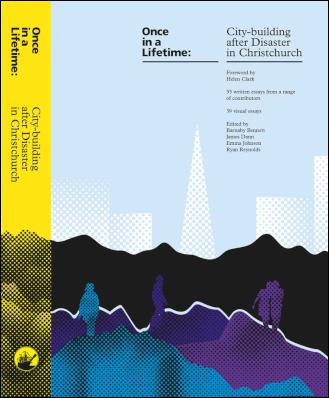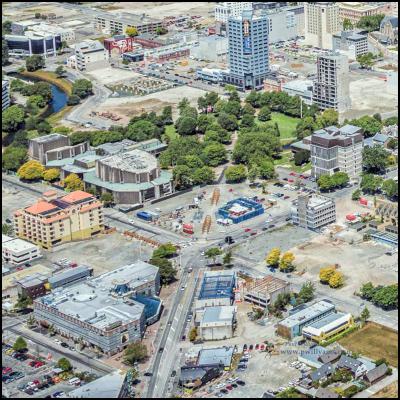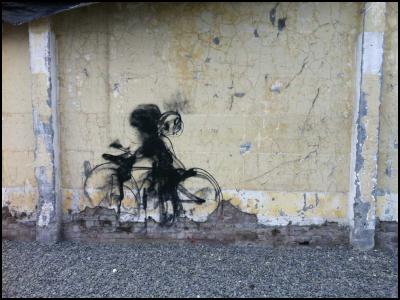Book Review by Alison McCulloch : Re-building Christchurch
Book Review by Alison McCulloch :
Re-building Christchurch
Once in
a Lifetime: City-building after Disaster in
Christchurch
Edited by Barnaby Bennett, James Dann,
Emma Johnson & Ryan Reynolds (Freerange Press,
$45)
Reviewed by Alison McCulloch November 22,
2014

BUY THE BOOK & FREE
RANGE
PRESS
Editor’s note: A Q&A with the book’s editors follows this review - discuss this book review at the Scoop Review Of Books.
Rather like the city it is imagining, this sprawling book is full of brilliant ideas, clever people and infectious enthusiasm, all leavened – as any city is – with a few cul de sacs best avoided.
And how could it not be: this impressive undertaking comprises 55 written essays (and 39 visual) from academics, activists, journalists, architects, as well as people with métiers I’m less sure about, like ecourbanists, spatial analysts, and futurists. It’s a potpourri (organic, for sure) and not the kind of book you should sit down to read right through. (Though if you do pull that off, it feels a bit like you’ve earned a bachelor’s in urban design theory, perhaps with a minor in futurism.)
Before diving in to the book’s content, it
might be useful here to offer up a few facts:
• As
well as the major quakes on 4 Sept. 2010 and 22 Feb. 2011,
Christchurch has suffered more than 13,000 aftershocks.
• 185 people from 17 countries died as a result of the
February quake.
• The entire recovery is estimated to
cost around $40 billion.
• Most major projects are
running behind schedule, and it’ll be at least 2020 before
they’re completed.
• 12,000 homes have been
demolished together with 1,500 commercial buildings.
As the editors state in their introduction, the title, Once in a Lifetime, suggests both an opportunity and a threat, and these disparate notions are threads that run through almost all the essays in the book.
Giving a good account of what is meant by the “threat” is Johnny Moore in an essay aptly titled “Beware when opportunity knocks”. Moore, the co-owner ofSmash Palace (a post-quake bar that’s as hard to categorise as this book) who also writes a column for the Press, doesn’t mince words: “There’s a bunch of fuckwits that have showed up from out of town and are telling the city how it should look and behave” he warns. They want a “slick and modern” kind of city full of beautiful people in which nothing bad ever happens. “They’ll put an Arts Precinct here, a Justice Precinct there and six lanes of traffic stampeding through the middle of the city so that imagined people can get to an imagined stadium that nobody needs.”
Indeed the whole “Precincts” part of the Christchurch Blueprint (Retail Precinct, Convention Centre Precinct, Health Precinct, Justice and Emergency Services Precinct, Innovation Precinct, Performing Arts Precinct) comes in for hefty doses of criticism throughout Once in a Lifetime. Moore argues that the kind of utopia envisaged by the Blueprint will turn out to be a nightmare not a dream. Cities need to be organic, to allow the bad as well as the good: they need vice as much as they need virtue, strips clubs as much as shiny Les Mills gyms.
Gary Franklin, in “On the Origin of Precincts”, makes a similar point, equally well: “In order to justify the $300 million Justice Precinct, a Vice Precinct is a must,” he writes. So how about including a “Slum Precinct” where creatives and others of lesser means can afford to live (and which might one day evolve into a “Hip Precinct”). The idea that cities should only be “designed” or “planned” only so far and no further – that they need to be living things not stale, dead ones – comes up again and again, though not always in as accessible a form as Moore and Franklin provide.

Click for big version
The Commons, aerial view 2013. Photo courtesy of Paul Willyams, www.pwillyams.co.nz
Indeed, some of the academic contributions are hard to wade through, reading more like Urban Design 101 lectures than anything a lay person (this reviewer) might connect with. (It struck me as oddly self-defeating to be arguing for overturning paradigms using a type of language and form that just seem to uphold them.) To make it in the university, you do have to coin phrases other academics can cite, but that’s what quarterly journals are for. The rest of us can do without “structures of participations” and “deliberative and inclusive participatory processes (or DIPs)”.
There are so many designers and architects and urban planners with impressive pedigrees represented here, I’ll not even try to mention them all. Alejandro Haiek Coll’s respectful puncturing of the architectural ego (“architecture is far too important to be left to architects”) is refreshing. He makes the point that most architecture is “oppressive, totalitarian and even militaristic”, and as such likes to spend time with power. It’s the architect’s job, he argues, to resist.
The suggestion that architects and urban planners are on the side of the powerful not the people, and need overthrowing, brings to mind a lovely line from Giovanni Tiso’s essay, “We weren’t laughing: Disaster capitalism and the earthquake recovery at L’Aquila”. Commenting on a planned suburb on the outskirts of Milan, Tiso describes it as a place “seemingly designed to breed consumers as opposed to citizens”.

Click for big version
Corner of Gloucester and Colombo streets, 15 April 2014. Attributed to Lister, image courtesy of Rueben Woods.
Tiso’s essay focuses on the aftermath of earthquakes in Italy, particularly the April 2009 quake in L’Aquila. There are warnings and parallels for Christchurch here, not to mention that Tiso, as such a gifted writer, is always a joy to read. (If you want more of Tiso, he blogs at Bat Bean Beam.) L’Aquila offers an example not only of what Naomi Klein has called “disaster capitalism” (exploiting crises in the service of power and private profit) but also of something like disaster authoritarianism (setting aside democracy and democratic institutions whenever disaster strikes, where “disaster” is defined by those same authorities). Tiso’s essay had me wandering off with thoughts about how curious it is that democracy, the political system universally lauded as the only one worth having, is apparently such a frail beast it must be set aside at the first hint of trouble. Rather like the fragility of our commitment to civil liberties in the face of over-blown terrorist threats. But I digress.
The recently resigned CEO of CERA (the Canterbury Earthquake Recovery Authority, and yes, acronyms have flourished in the aftermath of the quakes) Roger Sutton not surprisingly doesn’t buy that democracy was compromised in producing Christchurch’s Blueprint. “The Government was elected to run the country by the people,” he writes. “The work it decides to do is by mandate of the community and this recovery is part of that work.” And: “Christchurch needed to be reborn and it needed to be done immediately. Democracy gave us that opportunity and we took it with both hands so that the very people who chose the government to govern would be best served.” If I have his argument right, it’s that elected government can do anything they want because they were elected, even if it means doing away with bits of the democracy that elected them. Neat!
Thankfully, Once in a Lifetime is not all about Blueprints, Precincts, politics and architecture. There are essays on health, tangata whenua, environmentalism, volunteering, economics, heritage…
Gerard Smyth, a TV director, takes a look at the media equation in “Telling our own tales”, and wonders what happens after disaster strikes and there’s no one from mainstream television to report it. (When a tree falls…sort of thing.) Sure, there was lots of ‘disaster porn’ beloved of TV newscasts in the immediate aftermath of the quakes, but what about some of the less sexy goings on, like the ‘lock-up’ of designers and engineers given the task of producing a city plan in 100 days? Important, you’d think. So surely there’ll be someone on hand to record it. (Short answer: No.) After some wrangling, Smyth got himself into the room for half an hour. “Extraordinarily, to my knowledge, I now own the only footage from the time of the ‘lock up’,” he writes. “I have been asked by other broadcasting interests for the footage. It seems that this has already become the valuable footage it was always destined to be. But why was I the only one to knock on the door?”
New Zealand Herald journalist (and a native of Christchurch) Liam Dann’s essay reads almost as though it were written to respond to the questions raised by Smyth, which it immediately follows (an example of how nicely organised the book is): “I wouldn’t be doing anyone any favours if I were to sugar-coat reality and pretend there is not a high level of fatigue for Christchurch’s redevelopment story in Auckland,” Dann writes. (Let me not sugar coat my own fatigue, as a resident of RONZ – Rest of New Zealand – for EA – Everything Auckland.) The title of Dann’s piece quite simply says it all: “Will a plumber cost me more now? Christchurch from an Auckland perspective”.
Another favourite in my reading was Ryan Reynolds’ “Desire for the gap” – an account of the Gap Filler projects, some of which I saw first hand when I visited Christchurch several times last year. One project that’s recorded here that I’m sorry I didn’t see (and a good example of the simple genius of so many of these ideas) was the “Think Differently Book Exchange”:
a broken old commercial
refrigerator that was salvaged, placed on a vacant site and
filled with books at a time when the city libraries were all
closed. … Anything could have happened: everyone might
have ignored it, or someone might have ‘stolen’ all the
books, knocked it over or vandalised it. But people used it,
and kept donating books. And the neighbours started caring
for it, putting calls out over social media for more
donations when it was getting
empty.

Click for big version
Gap Filler’s Think Differently Book Exchange. Image courtesy of Ross Becker, 2011.
The gap fillers have been inspiring, and thankfully Reynolds’ chapter includes images since words can’t do them justice.
Indeed the myriad images
(including maps, photos, diagrams) are a strength of this
book. Amid all those words, the 39 visual essays offer
regular doses of relief. They would make a fantastic book
in their own right, especially if given the space and image
quality so many of them deserve, but don’t get here. This
is certainly not a criticism of this book’s editors – my
impression is they did their very best with the resources
they had; the book’s size and costs would surely have been
untenable if the pictures had been given anything close to
coffee-table-book treatment. Standouts for me among the
visual essays are on “Street art”, the “Broken
buildings” collection (its counterpart, “New
buildings” is a bit dispiriting, depicting for the most
part, functional “concrete, steel and glass” boxes.),
and of course “Protest signs”: ‘Nothing works here. I
hate this place’ and ‘KEEP CHCH GE(RRY) FREE’ …
which seems a perfect note on which to
close. BUY
THE BOOK AT FREERANGE
PRESS
Q & A With the Editors of Once in a Lifetime
Q. In the Introduction, the editors suggest a purpose of Once in a Lifetime is to change — or at least influence — the direction of the Christchurch rebuild before it’s too late. (Though in the Conclusion you say you had no clear outcome in mind.) What, if any, outcome/s have you seen since the book came out as a result of its compilation and publication?
A. Cities are complex things, and direct cause and effect is a rare thing. So can we point to anything that has happened as a direct result of the book? Certainly new relationships and communications across different organisations and a series of public discussions have resulted. More importantly though is that this book contributes to a whole series of different conversations and discussions in the city. Perspective is hard to find in such a busy and complex environment, so hopefully what we have enabled is for different people to take a step back, pause for a few moments and take look at some bigger issues.
For example, the Wellington mayor brought along representatives from NIWA, GIS, Red Cross, etc, to the Wellington book launch and gave a great and appreciative speech touching on how policies could be informed by what Once in a Lifetime revealed was working and not working in Christchurch.
Q. I kept thinking, wow, it must have been a ‘nightmare’ to try to pull something like this together. So, what was it like?
A. It was exhilarating, challenging and exhausting. There were four of us on the editorial team – nevertheless it was a mammoth task in terms of the content curation, collection and editing. So what started as a conversation over a year ago between the editorial team members then navigated through a vast network of decisions, discussions, deadlines and energy to culminate in this 512 page book – one that we feel, thanks to the striking imagery provided and the authors’ multi-disciplinary perspectives, allowed us to reflect within the book’s pages the many voices that make up a city. The challenges involved in working with so many collaborators were worth it. This book involved tremendous goodwill and the efforts of many.
Q. What’s next, if anything, in terms of writing about and publishing work on the Christchurch rebuild?
A. Freerange has a current focus on the issues, creativity and challenges arising out of post-quake Christchurch. In essence, our books are both about discussion and part of wider ones, and every discussion is infused with its moment. The energy and direction of Once in a Lifetime came from the city around us – so we will see what happens next in terms of publishing and writing about the rebuild.
Q. How are things going in Christchurch, anyway?
A. The city is booming in terms of employment and construction. It’s busy. Things are happening. Inevitably this feels more optimistic, but it is also dangerous as this optimism can cover up poor decisions and short sightedness. Almost four years after the quakes many people are getting burnt out and this is starting to show in various places around the city. See, for example, John McCrone in the Press: Residents Still Suffering From ‘Quake Brain’
Q. How was the book funded?
A. We wished to print in New Zealand so that we could affirm this book as one from New Zealand (from idea through to the object). On a more pragmatic level we wanted more time to prepare the book for the launch at the Word Christchurch Writers and Readers Festival. We had money from the sales ofChristchurch: The Transitional City Pt IV - but this was not enough to print here.Once in a Lifetime would not have been possible without the support of Creative New Zealand, Kiwibank, The Warren Trust, Gib, Resene and Spicers. We also received funding support of the Royal Society’s Marsden Fund and seven people loaned us some money – which has been paid back! Any profits will go back into making more books.
BUY
THE BOOK AT FREERANGE
PRESS
ENDS


 Martin LeFevre - Meditations: True Abundance
Martin LeFevre - Meditations: True Abundance Binoy Kampmark: Junk Science And Bad Policing - The Homicide Prediction Project
Binoy Kampmark: Junk Science And Bad Policing - The Homicide Prediction Project Keith Rankin: Rational Expectations, Intelligence, And War
Keith Rankin: Rational Expectations, Intelligence, And War Peter Dunne: Dunne's Weekly - Is Andrew Little Wellington's Mayor-In-Waiting?
Peter Dunne: Dunne's Weekly - Is Andrew Little Wellington's Mayor-In-Waiting? Gordon Campbell: On Peter Dutton’s Fading Election Prospects.
Gordon Campbell: On Peter Dutton’s Fading Election Prospects. Binoy Kampmark: Withdrawal Symptoms - Hungary, Europe And The International Criminal Court
Binoy Kampmark: Withdrawal Symptoms - Hungary, Europe And The International Criminal Court